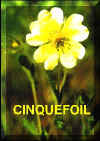
June-August |
Common Name: Cinquefoil
Latin Name: Potentilla spp.
Family: Rosaceae Potentilla is another genus that gives botanists
headaches. There are about 14 species in Michigan, two are listed as threatened and
a couple are widespread exotics. Other species are found around the globe on
suitable habitat. P.
norvegica may be the one we are
most familiar with, but there are other common species in Michigan, too. The yellow
flowers are rather conspicuous and resemble the pink or white "wild rose".
|

June-September |
Common Name: Silverweed
Latin Name: Potentilla
anserina
Family: Rosaceae
This plant is locally
abundant along roadsides near the Great Lakes. Found naturally on
gravel beds, usually near water. The compound leaf has toothed margins
and loosely resembles strawberry. Flowers are numerous and vegetation
forms a soft mat along roadsides. |
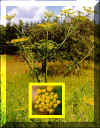
June-July |
Common Name: Wild Parsnip



Latin Name: Pastinaca sativa.
Family: Umbelliferae
Wild parsnip is an exotic species from Europe, probably
escaped from cultivation. It's a tall plant, about four feet tall,
with "yellow umbrellas" at the top. Individual flowers
are small and may appear sort of waxy. They never quite look like
they have fully bloomed. The plant is somewhat carrot-like looking.
It doesn't grow in the really dry, barren places along the road, but
more towards a ditch in moister soil. Juices from this plant can
cause a nasty rash or blisters, especially on hot, humid days when bare
skin comes into contact with the plant. Caution!
|
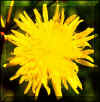
July-October |
Common Name: Sow Thistle
 

Latin Name: Sonchus arvensis
Family: Compsitae Sow thistles look like giant dandelions with bigger flower heads and prickly
leaves. There are usually 2-3 flower heads per plant, although this may vary.
While the heads may look like a single flower, they are actually many small flowers with
one of several functions.
|
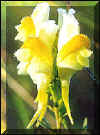
May-September |
Common Name: Butter 'n Eggs 

Latin Name: Linaria vulgaris
Family: Scrophulariaceae Butter 'n Eggs is a pretty European species in the
snapdragon family. The blooms are whitish with a strong yellow-orange color.
Some blooms resemble popcorn more than "butter and eggs". The flowers have
a long "tail", characteristic of the flowers in this family. Butter 'n
Eggs are often found in small colonies.
|

June-September |
Common Name: Hawkweed

Latin Name: Hieracium spp.
Family: Compositae
A genus of both native and exotic
species, the dozen (or more) hawkweed species are difficult to distinguish but as a genus
are easy to recognize. There are few orange flowers, especially along roadsides.
Hawkweeds look like orange dandelions on slender stalks, but there is no milky sap.
The intensity of orange varies, some are even yellow.
|
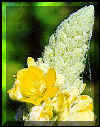
June-September |
Common Name: Mullein



Latin Name: Verbascum thapsis
Family: Scrophulariaceae Mullein is easy to identify year-round. The
tall, thick flower stalks are topped with a large spike of yellow flowers. The
large, fuzzy, soft leaves are mostly in the lower parts of the plant. During the
winter, mullein leaves stay green and the dry, brown stalks usually persist late into the
season.
|
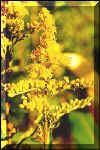
August-Sept |
Common Name: Goldenrod


Latin Name: Solidago spp.
Family: Compositae The showy goldenrod blooms might be the most
conspicuous color along roadsides and in old fields during the later summer and early
autumn. Sometimes goldenrod forms sweeping "seas of yellow" across large
open areas. The plants usually stand 2-3 feet tall and have variously-shaped flower
spikes. There are at least a couple dozen species. Houghton's goldenrod is on
the Michigan threatened plant list, but it is not a roadside species.
|
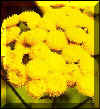
August-October |
Common Name: Common Tansy



Latin Name: Tanacetum vulgare
Family: Compositae Tansy has bright yellow flowers in broadly round-top
clusters. Individual flowers look like mini chrysanthemums but are usually no more
than a half-inch wide, but clusters may be 4-6 inches wide. The plants stands about
four feet tall. Crushed leaves have a spicy smell to them. The exotic plant is
widespread across Michigan but is not considered highly invasive. It most likely
escaped from flower gardens.
|
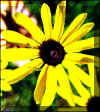
June-October |
Common Name: Black-eyed Susan 

Latin Name: Rudbeckia hirta
Family: Compositae Black-eyed Susan is another one of those very
familiar summer time flowers. The dark brown center and cheeful golden
"petals" can found along roadsides throughout the state. The blooms may be
up to three inches wide and the plants reach a height of up to three feet. Some
people might refer to Black-eyed Susans as yellow daisies, although daisies are another
genus altogether.
|
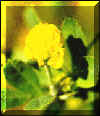
May-September |
Common Name: Hop Clover 

Latin Name: Trifolium aureum
Family: Leguminosae
Hop clover is an inconspicuous small
flower that grows close to the ground. The clusters of tiny flowers are about 1/4 to
1/2 inch in length. The leaves have that distinction "clover look" to
them. Most of the clovers in Michigan are exotics from Europe, including hop clover.
And like its cousins, it has escaped from cultivation as forage crops.
|
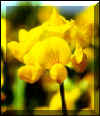
June-August |
Common Name: Birdsfoot Trefoil  

Latin Name: Lotus corniculata
Family: Leguminosae Birdsfoot trefoil is a brilliant yellow flower that
blooms during the height of summer. Along roadsides it can form solid stretchs of
dense vegetation, as well as large sweeping patches in old fields. It is classed as
mildly invasive and is often used as cover in deer openings. It won't grow in shade.
While native species are often preferred for wildlife plantings (if you really want
any), the seed is often hard to come by. Birdsfoot trefoil and clover seed stock is
readily available.
|
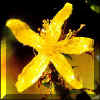
June-September |
Common Name: St. Johnswort


Latin Name: Hypericum perforatum
Family: Hypericaceae Scruffy-looking, five-part flowers with lots of
stamens will help identify St. Johnswort. Flowers are not a bright yellow and petals
often appear rather crumpled. There are about a dozen species in Michigan.
Most tend to have loose clusters of flowers at the top of the plant, which usually stands
2-3 feet tall.
|

April-July |
Common Name: Buttercups


Latin Name: Ranunculus spp.
Family: Ranunculaceae Buttercups have rather small flowers with five
petals. Sometimes the petals are notched and flowers look like they have more than
five petals. Plant heights vary considerably, from a foot to several feet, depending
upon the species and site. There are many species of buttercups in Michigan. |


![]() An
alien (or exotic species)
An
alien (or exotic species)
![]() Can be easily seen while driving
Can be easily seen while driving
![]() More information
More information![]() Michigan Invasive Plant Council Home Page
Michigan Invasive Plant Council Home Page